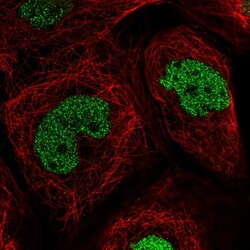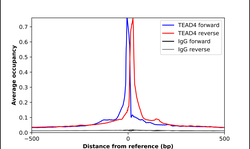Antibody data
- Antibody Data
- Antigen structure
- References [6]
- Comments [0]
- Validations
- Immunocytochemistry [1]
- Chromatin Immunoprecipitation [1]
Submit
Validation data
Reference
Comment
Report error
- Product number
- HPA056896 - Provider product page

- Provider
- Atlas Antibodies
- Proper citation
- Atlas Antibodies Cat#HPA056896, RRID:AB_2683268
- Product name
- Anti-TEAD4
- Antibody type
- Polyclonal
- Description
- Polyclonal Antibody against Human TEAD4, Gene description: TEA domain family member 4, Alternative Gene Names: EFTR-2, RTEF-1, TCF13L1, TEF-3, TEFR-1, Validated applications: IHC, ICC, ChIP, Uniprot ID: Q15561, Storage: Store at +4°C for short term storage. Long time storage is recommended at -20°C.
- Reactivity
- Human
- Host
- Rabbit
- Conjugate
- Unconjugated
- Isotype
- IgG
- Vial size
- 100 µl
- Concentration
- 0.1 mg/ml
- Storage
- Store at +4°C for short term storage. Long time storage is recommended at -20°C.
- Handling
- The antibody solution should be gently mixed before use.
Submitted references The multifaceted role of GCM1 during trophoblast differentiation in the human placenta
Histone deacetylase 1 and 2 drive differentiation and fusion of progenitor cells in human placental trophoblasts
TEA Domain Transcription Factor 4 Is the Major Mediator of Yes-Associated Protein Oncogenic Activity in Mouse and Human Hepatoblastoma
Comparative analysis of mouse and human placentae across gestation reveals species-specific regulators of placental development
TEAD1/4 exerts oncogenic role and is negatively regulated by miR-4269 in gastric tumorigenesis.
Human pluripotent stem cells as a model of trophoblast differentiation in both normal development and disease
Jeyarajah M, Jaju Bhattad G, Kelly R, Baines K, Jaremek A, Yang F, Okae H, Arima T, Dumeaux V, Renaud S
Proceedings of the National Academy of Sciences 2022;119(49)
Proceedings of the National Academy of Sciences 2022;119(49)
Histone deacetylase 1 and 2 drive differentiation and fusion of progenitor cells in human placental trophoblasts
Jaju Bhattad G, Jeyarajah M, McGill M, Dumeaux V, Okae H, Arima T, Lajoie P, Bérubé N, Renaud S
Cell Death & Disease 2020;11(5)
Cell Death & Disease 2020;11(5)
TEA Domain Transcription Factor 4 Is the Major Mediator of Yes-Associated Protein Oncogenic Activity in Mouse and Human Hepatoblastoma
Zhang J, Liu P, Tao J, Wang P, Zhang Y, Song X, Che L, Sumazin P, Ribback S, Kiss A, Schaff Z, Cigliano A, Dombrowski F, Cossu C, Pascale R, Calvisi D, Monga S, Chen X
The American Journal of Pathology 2019;189(5):1077-1090
The American Journal of Pathology 2019;189(5):1077-1090
Comparative analysis of mouse and human placentae across gestation reveals species-specific regulators of placental development
Soncin F, Khater M, To C, Pizzo D, Farah O, Wakeland A, Arul Nambi Rajan K, Nelson K, Chang C, Moretto-Zita M, Natale D, Laurent L, Parast M
Development 2018;145(2)
Development 2018;145(2)
TEAD1/4 exerts oncogenic role and is negatively regulated by miR-4269 in gastric tumorigenesis.
Zhou Y, Huang T, Zhang J, Wong CC, Zhang B, Dong Y, Wu F, Tong JHM, Wu WKK, Cheng ASL, Yu J, Kang W, To KF
Oncogene 2017 Nov 23;36(47):6518-6530
Oncogene 2017 Nov 23;36(47):6518-6530
Human pluripotent stem cells as a model of trophoblast differentiation in both normal development and disease
Horii M, Li Y, Wakeland A, Pizzo D, Nelson K, Sabatini K, Laurent L, Liu Y, Parast M
Proceedings of the National Academy of Sciences 2016;113(27)
Proceedings of the National Academy of Sciences 2016;113(27)
No comments: Submit comment
Supportive validation
- Submitted by
- Atlas Antibodies (provider)
- Main image

- Experimental details
- Immunofluorescent staining of human cell line A-431 shows localization to nucleoplasm.
- Sample type
- Human
Supportive validation
- Submitted by
- Atlas Antibodies (provider)
- Main image

- Experimental details
- ChIP-Exo-Seq composite graph for Anti-TEAD4 (HPA056896, Lot 000041808) tested in K562 cells. Strand-specific reads (blue: forward, red: reverse) and IgG controls (black: forward, grey: reverse) are plotted against the distance from a composite set of reference binding sites. The antibody exhibits robust target enrichment compared to a non-specific IgG control and precisely reveals its structural organization around the binding site. Data generated by Prof. B. F. Pugh´s Lab at Cornell University.
 Explore
Explore Validate
Validate Learn
Learn Immunocytochemistry
Immunocytochemistry Immunohistochemistry
Immunohistochemistry